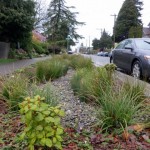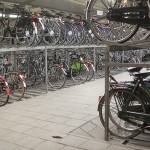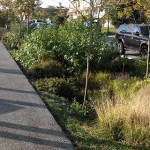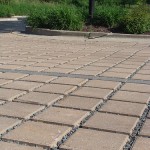Search Results
-
Germany: A Study in Sustainable Transportation
Here’s an oldie but a goody: a 2009 Brookings report on sustainable transportation in Germany. The upshot is that Germans enjoy a safer, more energy efficient, and more affordable transportation system than Americans do. (Germany almost certainly beats Canada too, though the article focuses on the US.) Just look at the numbers: compared with the US, Germany’s cars emit 1/3 the CO2 emissions per person, and cause less than half...Read more » -
Six Tips for Selling Green Stormwater Solutions
Congratulations! You’ve come up with a great idea for an affordable, attractive, environmentally sound solution for the polluted runoff that’s fouling Northwest rivers, lakes, and inland seas. But before you dig up that first shovel full of weedy grass to install your roadside rain garden, take heed: You must get the public (or in the case of a private development, your client) on board first! Puget Sound area governments have...Read more » -
Shifting Bike-and-Ride into Higher Gear
Most of us are familiar with park-and-ride facilities: large parking lots surrounding transit stops. They generally expand the effective “reach” of a transit stop by allowing people to combine automobiles and transit in a single trip. Yet they also have several disadvantages, including negative visual impacts, forgone revenue from other uses of the space, and the cost of the facilities themselves. There is a better way. In contrast to park-and-rides,...Read more » -
Weekend Reading 8/24/12
Clark: From Oregon Public Broadcasting, news of a new trend in Portland: housing without parking. It’s a major boon for affordability: according to one developer, the cost of providing parking makes “the difference between a $750 apartment and a $1,200 apartment. Or, the difference between apartments and condos.” And in more awesome news from the Rose City, the Oregon legislature has moved to allow Portland to create a network of...Read more » -
SeaTac’s Foreign-Born Boom
Last week, I wrote about the explosion in foreign-born residents in the Northwest. Next I thought it would be interesting to dig a little deeper into the demographics of one of Washington’s most diverse communities: SeaTac. The South King County city is a mix of 1950s homes with manicured lawns, cul de sacs with a boat in every third driveway, and dense apartment buildings that serve as nuclei for refugees...Read more » -
A New Era for Stormwater Management
One of the best policy opportunities to restore Puget Sound will be unveiled this week. It’s incredibly important but, unfortunately, it also sounds incredibly boring. And that means it’s likely to be overlooked by a whole boatload of people who should care. Here’s the scoop: on August 1, the Washington Department of Ecology is scheduled to issue its National Pollutant Discharge Elimination System (NPDES) final Phase I Municipal Stormwater General...Read more » -
Seattle Reforms Outdated and Unhelpful Regulations
It’s been almost a year since the idea took shape, but yesterday the Seattle city council unanimously approved a smart package of regulatory reforms that Sightline has been supporting. The reforms give a boost to urban sustainability by making it easier to build walkable and affordable communities and by encouraging small-scale entrepreneurship. Councilmember Richard Conlin deserves plaudits for ably guiding the rather complex (and occasionally controversial) legislation through committee and...Read more » -
Promise of Permeable Pavement
Editor’s note: This post is also available as a pdf. Permeable pavement is one of the most promising green solutions that can help reduce and clean up polluted stormwater runoff. Like conventional pavement, it can be made of asphalt or concrete that’s either poured in place or sold as pavers, and it can be used in a variety of settings, including on parking lots, low-traffic roadways, driveways, and sidewalks. Permeable...Read more » -
The Promise of Permeable Pavement
Permeable pavement is one of the most promising green solutions that can help reduce and clean up polluted stormwater runoff. Like conventional pavement, it can be made of asphalt or concrete that’s either poured in place or sold as pavers, and it can be used in a variety of settings, including on parking lots, low-traffic roadways, driveways, and sidewalks.Read more » -
Weekend Reading 6/15/12
Eric dP: I’ve got a pair of good suggestions this week. In the Vancouver Observer, Barry Saxifrage looks at national emissions trends and reveals that the world leader is—it’s hard to believe it, but it’s true—the United States. And as he points out, US reductions are no small potatoes: How big is a cut of 430 million tonnes of CO2? It’s equal to all CO2 from all Canadians outside Alberta....Read more »








